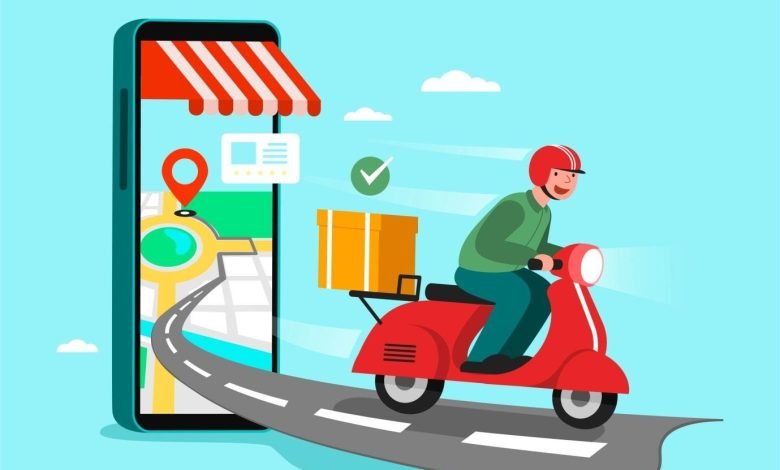
Every business has been affected by the rising on-demand economy in recent years, and the food sector is no different. However, due to the COVID-19 pandemic, on-demand Food Delivery Platforms have seen a sharp increase in daily downloads and have started to become a worldwide phenomenon.
Food delivery companies like Swiggy and Zomato saw a decline in orders from March to May 2020 in India due to the coronavirus (COVID-19) outbreak. Following the lockdown, demand was once more boosted by new work arrangements including working from home.
2,613.2 million Users are anticipated in the on-demand food delivery marketplace by 2027, and revenue of On-Demand Food Delivery Industry is anticipated to reach US$323.30 billion in 2022.
Why are apps for food delivery profitable?
Businesses are going digital as the digital era dawns, simplifying, expediting, and improving people’s lives. Nowadays, people have so little time for their daily tasks that they look for prompt solutions at fair costs right outside their door.
On-demand mobile applications thrive in this environment due of its simplicity. With a simple touch on your phone, you can order anything you need, including cabs, movie tickets, meals, hotel reservations, and more. This is the reason why every business is now concentrating on developing mobile applications.
Specially On-Demand Food Delivery Apps, they are booming in current markets. Because the future is so dependent on software the demand for food delivery app surges high every day. The primary reason for food delivery app profitability is they offer win-win solutions for providers and customers. As we all know modern life would not be the same without on-demand services.
Features of On-demand Food Delivery Platforms
Push Notifications in an App for Ordering Food on Demand:
Having many meal delivery apps on your smartphone is clear given the explosive growth of online food ordering. The greatest strategy to get exposure and maintain an advantage over your rivals is to send push alerts. It enables companies to maintain contact with their clients. These messages assist in disseminating a variety of information, including offers, discounts, location-based order dropped messages, and so forth.
You should also make sure that your on-demand food ordering app’s notifications offer customers something of value in addition to being purely promotional. Aim to manage push notifications so that they significantly aid in the expansion of your business app. Inform prospective clients on a regular basis with promotions, deals, and loyalty programmes.
Providing the Delivery Person’s Contact Information:
Let’s imagine that the client placed an order and paid for it. The consumer’s contact information for the delivery person may be provided. Customers can thus get in touch with the delivery person and track their products thanks to the feature.
Programs for rewards and discounts, cashback, and loyalty
The best approaches to get more people to use your food delivery app are coupons and special deals. In order to maintain customer attention, you need constantly provide large discounts.
It’s more crucial to draw in potential customers than to increase brand awareness if you want to earn customer loyalty. Large businesses prioritise their reward points more because of this. Thus, after implementing loyalty programmes, Starbuck, for instance, reported an 80% boost in sales.
Real-Time Food Delivery GPS Tracking:
Customers can use real-time GPS to follow the whereabouts of their meal thanks to one of the key features of food delivery apps. GPS is designed to function and provide two-way tracking. Recognizing the user’s location makes it easier to deliver food. Users can also simply follow the delivery team’s progress and movement once the region has been verified.
The top food delivery apps use it to provide their users with the finest possible service. A few excellent APIs for this feature are MapKit, Waze’s Navigation, or Google Maps. Uber, for instance, utilises Google Maps across all platforms.
Query Filters:
Customers will value the convenience and time savings that a comprehensive search function with multiple parameters may offer because it gives them the freedom to find the restaurants they want and allows them to place orders from them. Because menu options differ from location to location, users should search for goods based on distance, delivery times, or even menu choices. More is needed for an app for a single restaurant or chain.
Types of on-demand delivery software/apps
On-Demand Restaurant/Food Delivery Apps:
Apps for restaurants and food delivery let clients place orders for meals at their convenience by connecting them with nearby eateries. For simple access by the customer, the restaurants publish all the necessary details about their menu on the app, including ingredients and price. The same app may be used to follow the progress of the meal delivery service after the order has been placed. Zomato is the most well-known example of such an app.
Zomato is a food delivery service and restaurant aggregator that offers details, menus, and reviews about nearby eateries. More than 10,000 cities are covered by its services, which are offered in 24 different countries and are used by clients all over the world.
Apps for on-demand grocery delivery:
The need for on-demand grocery delivery apps has risen as a result of COVID-19. Such apps allow users to place online orders and provide information about the products’ availability at neighbouring supermarkets.
One well-known illustration is Instacart. It is a delivery and pickup service for groceries that is available in both the US and Canada. Customers are able to order from retailers via its website and mobile app. But in this instance, a personal shopper shops on the customer’s behalf and selects, packs, and delivers the order within a predetermined time range.
On-Demand Retail Delivery Apps:
Another industry that has been significantly impacted by on-demand is retail and eCommerce. Customers may purchase practically anything quickly and with a variety of options thanks to an on-demand retail delivery app. Customer can order soft drinks, biscuits, wafers, and even any fritters using retail delivery apps.
Consumer platform delivery:
Consumer platform delivery works as an aggregator app where users can look up menus and find various restaurants. Additionally, customers can verify and compare prices before making a choice.
Restaurant-to-consumer delivery:
These applications provide access to a certain restaurant’s menus.
For Example:
Dominos
This app has options for tracking orders, custom orders, online ordering, in-app payments, and browsing. This software has a very straightforward user interface and simple navigation.
McDonald
Customers have come to expect a top-notch dining experience from the McDonald’s app. Over the previous few years, this has led to more than 7 million downloads, and the graph is gradually going up. The app provides a variety of options to sate its users’ desires, and both the registration and ordering processes are remarkably simple.
Pizza Hut
The guest checkout option at Pizza Hut sets it apart from other online on-demand food delivery apps, which must have all the necessary capabilities.
Conclusion
The aforementioned features are a requirement for your app to Improve Your Food Delivery Service and to enhance your customer experience, regardless of whether you’re a restaurant owner looking to increase sales, client loyalty, or retention rate, or an entrepreneur investing in your next big project of an On-Demand Food Delivery service.
However, if you want to thrive in such a competitive market, you should make an app that is not user friendly but unique and distinctive. To build such a fascinating app you should take help of Food Delivery App Development service provider.
They will be happy to help you create an On-Demand Food Delivery Software with their skilled app developers. Hence don’t just survive in this cut-throat competition, thrive fruitfully developing On-demand Food Delivery apps.




I don’t think the title of your article matches the content lol. Just kidding, mainly because I had some doubts after reading the article.
Can you be more specific about the content of your article? After reading it, I still have some doubts. Hope you can help me.
I don’t think the title of your article matches the content lol. Just kidding, mainly because I had some doubts after reading the article.
Can you be more specific about the content of your article? After reading it, I still have some doubts. Hope you can help me.
I don’t think the title of your article matches the content lol. Just kidding, mainly because I had some doubts after reading the article.
Can you be more specific about the content of your article? After reading it, I still have some doubts. Hope you can help me.
Can you be more specific about the content of your article? After reading it, I still have some doubts. Hope you can help me. https://www.binance.info/zh-CN/register?ref=VDVEQ78S